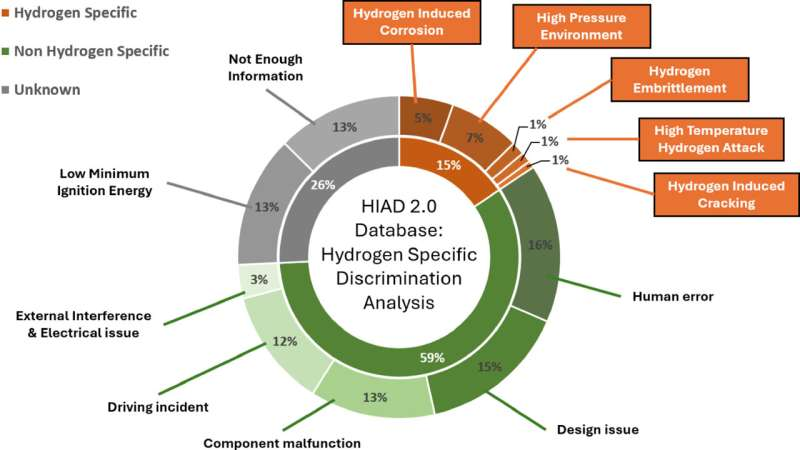Hydrogen processing plant failures mostly linked to design flaws, not hydrogen itself, study finds
Hydrogen is often touted as a clean, carbon-free energy carrier that could help decarbonize industry and transportation. Yet the very properties that make it efficient and lightweight also make it uniquely tricky to handle safely.
A new study published in the International Journal of Hydrogen Energy by researchers at NYU Tandon and University College London takes a systematic look at what truly makes hydrogen accidents different from conventional industrial failures, and what that means for safety and regulation.
By analyzing more than 700 incidents in the Hydrogen Incidents and Accidents Database (HIAD 2.0), the team found that 59% of mishaps involving hydrogen stem from the same sorts of issues that plague other energy systems: design flaws, mechanical failures, and human error.
Only 15% can be directly traced to the intrinsic properties of hydrogen itself, such as its high diffusivity, low ignition energy, or ability to degrade metals from within. The remaining cases lacked enough detail to tell one way or another.
Lead author Augustin Guibaud, Assistant Professor of Mechanical and Aerospace Engineering, says:
Of course, in the case of hydrogen, the consequences of a fire or an explosion can be a lot more severe due to the unique combustion properties of this gas.
“But when looking at the root cause of an incident, hydrogen is not inherently more dangerous than other flammable gases used in industry.However, the way it interacts with materials and the environment is fundamentally different. The danger comes from misunderstanding those differences.”
Those differences arise from hydrogen’s atomic scale. Its extremely small molecules slip through metal lattices where larger gases like methane cannot, leading to subtle but serious material failures.
The study details several such mechanisms: hydrogen embrittlement, which weakens metals by disrupting atomic bonds; hydrogen-induced cracking, in which pressurized gas accumulates inside tiny voids until the material bursts; and high-temperature hydrogen attack, where hydrogen reacts with carbon in steel to form methane, eroding its structure. Other hazards include hydrogen-assisted corrosion and the effects of storing the gas at pressures up to 700 bar—dozens of times higher than those used for natural gas.
These microscopic processes have huge consequences. The 2019 explosion at a hydrogen refueling station in Sandvika, Norway, for example, stemmed from a faulty high-pressure component rather than combustion chemistry, but it underscored how even small mechanical flaws can escalate quickly under hydrogen service conditions.
Guibaud, who is also a member of the Center for Urban Science + Progress, notes that the goal of the research is not to minimize hydrogen’s risks but to clarify them. “Our findings also highlight where traditional safety practices fail to capture hydrogen’s unique behavior. If we can distinguish between what is general and what is hydrogen-specific, we can focus regulation and design standards on the right problems.”
That distinction, the authors argue, is essential as hydrogen infrastructure expands beyond controlled industrial sites into urban fueling stations, residential heating, and renewable power storage. Current regulations, they point out, often apply “one-size-fits-all” safety distances or design codes that lack a strong scientific basis. Overly cautious rules can slow deployment and raise costs, while overly permissive ones can leave gaps in protection.
Instead, the researchers advocate for risk-informed, evidence-based safety standards grounded in hydrogen’s particular chemistry and physics. They also call for improved data collection and international coordination, noting that the hydrogen industry today lacks the tools to improve systematic data collection and transparency.
Guibaud, says:
The challenge,
“isn’t just preventing accidents—it’s learning from them fast enough to guide a rapidly changing energy landscape.” As hydrogen moves from the lab to the mainstream, knowing which failures are truly “hydrogen failures” may prove as vital as the technology itself.
READ the latest news shaping the hydrogen market at Hydrogen Central
Hydrogen processing plant failures mostly linked to design flaws, not hydrogen itself, study finds, source


